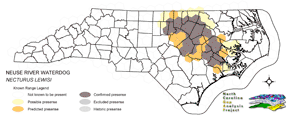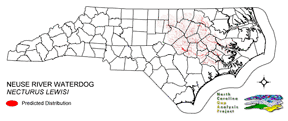
| Taxa: |
| Order: |
| Family: |
| Amphibia |
| Caudata |
| Proteidae |
| NatureServe Global Rank: |
| NatureServe State (NC) Rank: |
| G3 |
| S3 |
| Federal Status: |
| NC State Status: |
| --- |
| SC |


| Land Unit |
| US Fish & Wildlife Service |
| US Forest Service |
| US National Park Service |
| US Department of Defense |
| NC State Parks |
| NC University System |
| NC Wildlife Res. Com. |
| NC Forest Service |
| NC Div. of Coastal Mgmt. |
| Local Governments |
| Non-Governmental Org. |
| Other Public Lands |
| Private Lands |
| GAP Status 1-2 |
| All Protected Lands |
| Statewide |
| Hectares |
| 151.38 |
| 842.40 |
| 1,900.17 |
| 0.00 |
| 439.02 |
| 991.71 |
| 2,505.06 |
| 10.89 |
| 0.00 |
| 293.76 |
| 187.02 |
| 75.69 |
| 191,710.62 |
| 2,165.49 |
| 5,592.78 |
| 199,107.72 |
| Acres |
| 374.07 |
| 2,081.62 |
| 4,695.42 |
| 0.00 |
| 1,084.84 |
| 2,450.57 |
| 6,190.14 |
| 26.91 |
| 0.00 |
| 725.90 |
| 462.14 |
| 187.03 |
| 473,727.17 |
| 5,351.04 |
| 13,820.06 |
| 492,005.80 |
| % of Dist. on |
| Prot. Lands |
| 2.7 % |
| 15.1 % |
| 3.5 % |
| 0.0 % |
| 7.8 % |
| 17.7 % |
| 43.2 % |
| 0.2 % |
| 0.0 % |
| 3.3 % |
| 3.3 % |
| 1.4 % |
| 0.0 % |
| 38.7 % |
| ----- |
| ----- |
| % of Dist. on |
| All Lands |
| < 0.1 % |
| 0.4 % |
| 1.0 % |
| 0.0 % |
| 0.2 % |
| 0.5 % |
| 1.3 % |
| < 0.1 % |
| 0.0 % |
| 0.1 % |
| < 0.1 % |
| < 0.1 % |
| 96.3 % |
| 1.1 % |
| ----- |
| ----- |
|
The Neuse River waterdog is endemic to North Carolina. Martof et al. (1980) states, 'It inhabits the main streams and larger tributaries of the Neuse and Tar rivers from well above tidewater into the lower piedmont.' Quiet, backwaters and floodplain swampy areas with large amounts of leaf litter covering the substrate have been identified by some as the principal habitat of this species (Martof et al. 1980, Wilson 1995). However, others identify main channels of moderately sized streams with hard-clay substrate as the waterdog's primary dwelling place (Petranka 1998). From the studies leading to these differing observations, it is clear that the entire body of water is utilized, perhaps in support of different eco- biological functions. NATURE SERVE GLOBAL HABITAT COMMENTS: Stream dweller requiring relatively high oxygen levels and water quality (Ashton 1990). Among large accumulations of submerged leaves in eddies, or backwaters of streams (Bury et al. 1980). Eggs are attached to underside of objects in water. NATURE SERVE STATE HABITAT COMMENTS: In Piedmont and along fall line it inhabits moderate to swift flowing streams. In coastal plain it is found in or near the main stream of the Neuse and Tar rivers and their major tributaries. |
| Code | Name | Description | NC Natural Heritage Program Equivalent |
| 50 | Coastal Plain Mixed Bottomland Forests | Includes forests dominated by a variety of hardwood species, including sweetgum, cottonwood, red maple. | Coastal Plain Bottomland Hardwood (in part), Coastal Plain Levee Forest |
| 49 | Coastal Plain Oak Bottomland Forest | Bottomland forests dominated by deciduous oak alliances. Oaks represented can include swamp chestnut, cherrybark, willow, and/or overcup oak. Inclusions of loblolly pine temporarily flooded forests occur in patches. Hydrology is temporarily to seasonally flooded. | Coastal Plain Bottomland Hardwoods (in part) blackwater subtype, brownwater subtype |
| 15 | Seepage and Streamhead Swamps | Includes extensive peat flats in the coastal plain, dominated by swamp tupelo, maples, and Atlantic white cedar alliances. In the sandhills includes streamhead pond pine and bay forests alliances. Saturated hydrology. | Bay Forest, Small Depression Pocosin, Streamhead Atlantic White Cedar Forest, Streamhead Pocosins |
| 30 | Cypress-Gum Floodplain Forests | Swamps dominated by black or swamp tupelo with or without Taxodium. Seasonally to semi-permanently flooded hydrology. | Cypress-Gum Swamps |
| 78 | Pond-Cypress - Gum Swamps, Savannas and Lakeshores | Cypress dominated swamps and lakeshores. Can include bays dominated by pond cypress or shorelines of coastal plain lakes with a narrow band of cypress. | Non-riverine Swamp Forest, Natural Lakeshores (in part) |
| 385 | Oak Bottomland Forest and Swamp Forest | The swamp chestnut oak, cherrybark oak, shumard oak and sweetgum alliance is one representative. Other alliances are dominated by water, willow, and overcup oaks. Swamp forests can be dominated by sweetgum, red maple, and black gum being dominant. Loblolly can occur in combination with sweetgum and red maple, or with tulip poplar. Includes saturated and semi- to permanently flooded forests in the mountains. | Piedmont/Mountain Bottomland Forest, Piedmont/Mountain Swamp Forest |
| 238 | Piedmont/Mountain Submerged Aquatic Vegetation | Seasonally to permanently flooded areas with aquatic vegetation. Waterlily, pondweed, hydrilla smartweed are a few of the species that can occur. | Piedmont/Mountain Semipermanent Impoundment (in part) |
| 239 | Piedmont/Mountain Emergent Vegetation | Emergent vegetation of all wetland hydrologies. Sites would commonly support species such as tussock sedge, rushs, and cattail alliances. | Rocky Bar and Shore (in part) |
| 269 | Floodplain Wet Shrublands | Saturated shrublands of the Piedmont, includes buttonbush, swamp-loosestrife, decodon and alders. | Piedmont/mountain Semipermanent Impoundment |
| 384 | Piedmont/Mountain Mixed Bottomland Hardwood Forests | Includes temporarily to seasonally forests dominated by hardwood species. Hardwoods include sweetgum, red maple, sycamore which co-occur in a mosaic of bottomland and levee positions. Includes alluvial hardwood forests in the mountains. Hemlock and white pine may occur as inclusions, but are generally mapped separately. | Piedmont/Mountain Alluvial Forest, Piedmont/Mountain Levee Forest |
| 8 | Open water | Open water without aquatic vegetation. | No equivalent |
|
Maxson, L. R., P. E. Moler, and B. W. Mansell. 1988. Albumin evolution in salamanders of the genus NECTURUS. J. Herpetol. 22:231-235.
Wilson, L. A. 1995. The Land Manager's Guide to the amphibians and reptiles of the South. Chapel Hill, NC: The Nature Conservancy. Petranka, J. W. 1998. Salamanders of the United States and Canada. Washington DC: Smithsonian Inst. Press. Ashton, R. E., Jr. 1990. NECTURUS LEWISI. Cat. Am. Amph. Rept. 456.1-456.2. Guttman, S. I., et al. 1990. An electrophoretic analysis of NECTURUS from the southeastern United States. J. Herpetol. 24:163-175. Behler, J. L., and F. W. King. 1979. The Audubon Society field guide to North American reptiles and amphibians. Alfred A. Knopf, New York. 719 pp. Bury, R. B., C. K. Dodd, Jr., and G. M. Fellers. 1980. Conservation of the Amphibia of the United States:a review. U.S. Fish and Wildlife Service, Washington, D.C., Resource Publication 134. 34 pp. Martof, B. S., W. M. Palmer, J. R. Bailey, and J. R. Harrison, III. 1980. Amphibians and reptiles of the Carolinas and Virginia. University of North Carolina Press, Chapel Hill, North Carolina. 264 pp. |
For more information please contact them at:
NC-GAP Analysis Project
Dept. of Zoology, NCSU
Campus Box 7617
Raleigh, NC 27695-7617
(919) 513-2853
www.basic.ncsu.edu/ncgap